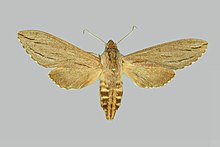Sphinx sequoiae
| Sphinx sequoiae | ||||||||||||
|---|---|---|---|---|---|---|---|---|---|---|---|---|

Sphinx sequoiae , male |
||||||||||||
| Systematics | ||||||||||||
|
||||||||||||
| Scientific name | ||||||||||||
| Sphinx sequoiae | ||||||||||||
| Boisduval , 1868 |
Sphinx sequoiae is a butterfly ( moth ) fromthe swarm family (Sphingidae).
features
The moths have a fore wing length of only 22 to 35 millimeters. The size alone distinguishes the species from all other species, with the exception of Sphinx dollii . The forewings are gray on top with a bluish cast. In the case of the similar species, this is instead brown. The similar species is also more patterned on the forewings. A black line runs diagonally across the wing from the base to the wing tip, but unlike the similar species, it is interrupted and less developed. On the thorax there is a pair of black longitudinal lines, in Sphinx dollii there are two pairs, which often merge into a broad, dark band. The species is variable in its coloring to a lesser extent in its pattern. In the south of their distribution, the moths are paler than in the north.
The caterpillars look similar to those of Sphinx dollii . They have a strong green base color and are provided with a series of white dots on each body segment. As a result, they are perfectly camouflaged on the young shoots of the food plants. Unlike the similar species, rows of brown spots are always formed on the back and below the spiracles . The brown spots are variable in size.
The pupa has conspicuously transparent green colored wing sheaths and an otherwise light brown colored abdomen. The very short proboscis sheath is free and only slightly curved away from the body. The short Kremaster is dark and ends in a double point.
Occurrence
The species is distributed in the north to the west of the Great Basin in southern Oregon and in northeast California. To the south, the distribution extends west of the Sierra Nevada and the Mojave Desert to Baja California Norte in Mexico. In the literature there are individual finds from Arizona and Nevada, whereby it was Sphinx dollii .
Sphinx sequoiae inhabits coniferous forests of moderate to medium altitudes in Oregon and California.
Way of life
The way of life of the species has hardly been researched. The moths fly to light sources at dusk. When visiting the flowers , they were detected on Eriodictyon , Virginian bird cherry ( Prunus virginiana ) and California horse chestnut ( Aesculus californica ).
Flight and caterpillar times
The moths fly from May to July, presumably in one generation.
Food of the caterpillars
The caterpillars have only been found on Utah juniper ( Juniperus osteosperma ) and giant arborvitae ( Thuja plicata ). In the western part of the Sierra Nevada, where no juniper grows, it is believed that the species feeds on incense cedar ( Calocedrus decurrens ). It is also said to eat California Juniper ( Juniperus californica ).
development
The way the females lay their eggs is unknown. Pupation takes place in a chamber just below the surface of the earth.
supporting documents
Individual evidence
- ↑ a b c d e f g h i James P. Tuttle: The Hawkmoths of North America, A Natural History Study of the Sphingidae of the United States and Canada. The Wedge Entomological Research Foundation, Washington, DC 2007, ISBN 978-0-9796633-0-7 .
- ↑ Sphingidae of the Americas. Bill Oehlke, accessed December 30, 2011 .
literature
- James P. Tuttle: The Hawkmoths of North America, A Natural History Study of the Sphingidae of the United States and Canada. The Wedge Entomological Research Foundation, Washington, DC 2007, ISBN 978-0-9796633-0-7 .
